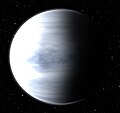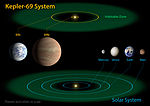Kepler-1652b (also known by its Kepler Objects of Interest designation KOI-2626.01) is a super-Earth exoplanet, orbiting within the habitable zone of the...
7 KB (772 words) - 11:10, 16 June 2024
proven a false positive by NASA in 2015. Several other KOIs, like Kepler-577b and Kepler-1649b, were considered potentially habitable prior to confirmation...
59 KB (3,204 words) - 03:49, 20 November 2024
Kepler-22 is a Sun-like star in the northern constellation of Cygnus, the swan, that is orbited by 1 planet found to be unequivocally within the star's...
10 KB (659 words) - 21:55, 24 August 2024
Kepler-1649c is an Earth-sized exoplanet, likely rocky, orbiting within the habitable zone of the red dwarf star Kepler-1649, the outermost planet of...
10 KB (885 words) - 21:09, 14 January 2024
This is a partial list of exoplanets discovered by the Kepler space telescope, running from star number 1501 through 2000, inclusive. All lists: 1–500...
23 KB (284 words) - 14:25, 8 September 2024
Kepler-1625b is a super-Jupiter exoplanet orbiting the Sun-like star Kepler-1625 about 2,500 parsecs (8,200 light-years) away in the constellation of...
11 KB (1,060 words) - 20:18, 2 November 2024
Kepler-70, also known as KIC 5807616 and KOI-55, is a star about 3,600 light-years (1,100 parsecs) away in the constellation Cygnus, with an apparent visual...
12 KB (1,094 words) - 18:13, 23 August 2024
TRAPPIST-1f TRAPPIST-1g K2-3d, a low-density planet near the habitable zone Kepler-1652b, a potentially habitable super-Earth Habitability of red dwarf systems...
15 KB (1,630 words) - 02:49, 29 September 2024
Kepler-186 is a main-sequence M1-type dwarf star, located 177.5 parsecs (579 light years) away in the constellation of Cygnus. The star is slightly cooler...
17 KB (1,540 words) - 03:22, 3 November 2024
Kepler-1649b is a Venus-like exoplanet orbiting Kepler-1649. Kepler-1649 is a type-M red dwarf star estimated to be roughly ¼ the radius of the Sun with...
2 KB (144 words) - 23:46, 15 August 2024
Kepler-1708b (previously known as KIC 7906827.01) is a Jupiter-sized exoplanet orbiting the Sun-like star Kepler-1708, located in the constellation of...
14 KB (1,305 words) - 04:34, 21 November 2024
Kepler-443b is an exoplanet about 2,540 light-years from Earth. It has an 89.9 percent chance of being in the star's habitable zone, yet only a 4.9 percent...
4 KB (273 words) - 20:32, 20 January 2024
from the Kepler space telescope and confirmed in 2015. None of the planets orbit within the habitable zone. Kepler-445b, c, and d orbit Kepler-445 every...
6 KB (348 words) - 02:01, 27 September 2023
Kepler-452 is a G-type main-sequence star located about 1,810 light-years away from Earth in the Cygnus constellation. Although similar in temperature...
13 KB (1,189 words) - 08:01, 9 May 2024
Kepler-34b (formally Kepler-34(AB)b) is a circumbinary planet announced with Kepler-35b. It is a small gas giant that orbits every ~288 days around two...
3 KB (240 words) - 00:11, 27 September 2023
Kepler-11, also designated as 2MASS J19482762+4154328, is a Sun-like star slightly larger than the Sun in the constellation Cygnus, located some 2,110...
18 KB (1,553 words) - 04:47, 29 August 2024
Kepler-1658b (or the Kepler object of interest, KOI-4.01) is a hot Jupiter, a type of gas giant exoplanet, that orbits an F-type star called Kepler 1658...
13 KB (1,262 words) - 05:28, 29 July 2024
Kepler-385 (also designated KOI-2433) is an F-type main-sequence star located about 4,900 light-years (1,500 parsecs) away from Earth in the constellation...
7 KB (471 words) - 19:30, 20 September 2024
stars which have lifespans much longer than other main sequence stars. Kepler-1652b is potentially an eyeball planet. The TRAPPIST-1 system may contain several...
5 KB (442 words) - 11:14, 5 November 2024
Kepler-1625b I is a possible moon of exoplanet Kepler-1625b, which may be the first exomoon ever discovered (pending confirmation), and was first indicated...
7 KB (602 words) - 20:19, 2 November 2024
two planets announced are designated Kepler-47b, and Kepler-47c, and the third, later discovery is Kepler-47d. Kepler-47 is the first circumbinary multi-planet...
23 KB (2,151 words) - 08:11, 17 November 2024
Kepler-409b is a super-Earth orbiting Kepler-409, a G-type main-sequence star. Its orbital period around the star is 69 days. Kepler-409b has a radius...
3 KB (267 words) - 01:59, 2 September 2024
Kepler-283 c is an exoplanet orbiting the K-type star Kepler-283 every 93 days in the circumstellar habitable zone, discovered by the Kepler space telescope...
4 KB (206 words) - 16:25, 13 August 2024
Kepler-69 (KOI-172, 2MASS J19330262+4452080, KIC 8692861) is a G-type main-sequence star similar to the Sun in the constellation Cygnus, located about...
9 KB (688 words) - 20:53, 28 June 2024
Kepler-87c is a planet orbiting Kepler-87, a star slightly more massive than the Sun and nearing the end of its main-sequence period. Despite being larger...
3 KB (145 words) - 09:09, 18 April 2024
Kepler-5 is a star located in the constellation Cygnus in the field of view of the Kepler Mission, a NASA project aimed at detecting planets in transit...
13 KB (1,072 words) - 06:55, 28 August 2024
Kepler-67 is a star in the open cluster NGC 6811 in the constellation Cygnus. It has slightly less mass than the Sun and has one confirmed planet, slightly...
4 KB (274 words) - 04:03, 30 April 2024
Kepler-737b is a super-Earth exoplanet 669 light years away. There is a chance it could be on the inner edge of the habitable zone. Kepler-737b is an exoplanet...
11 KB (1,244 words) - 09:02, 21 April 2024
Kepler-16 is an eclipsing binary star system in the constellation of Cygnus that was targeted by the Kepler spacecraft. Both stars are smaller than the...
9 KB (489 words) - 10:30, 9 May 2024
away from Earth. Prior to Kepler observation, Kepler-432 had the 2MASS catalogue number 2MASS J19330772+4817092. In the Kepler Input Catalog it has the...
11 KB (1,043 words) - 21:41, 19 April 2024











